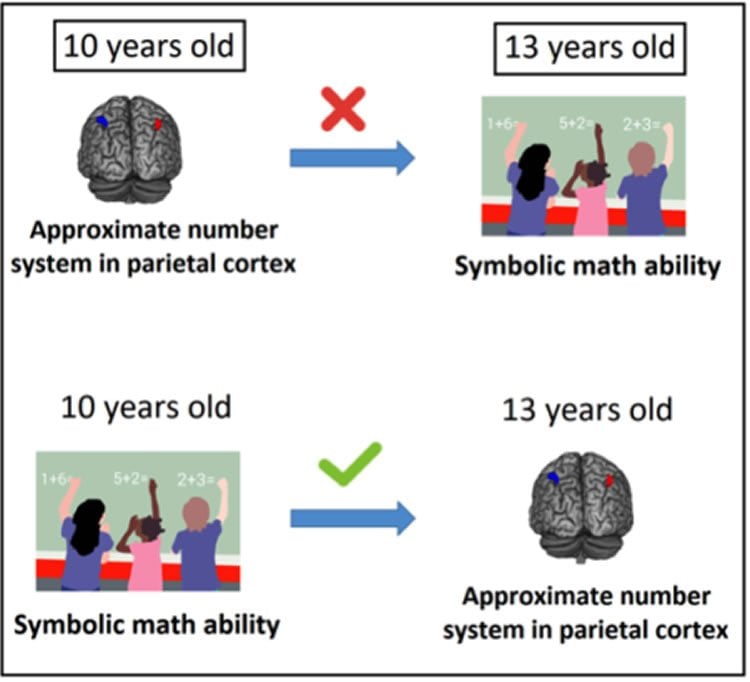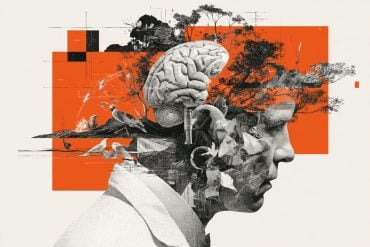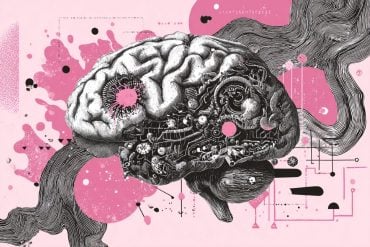Summary: A new study reports gaining expertise with symbolic math refines the primal system of quantity representation in the brain, not the other way around.
Source: Vanderbilt University.
A wildebeest knows when it is outnumbered by a pack of hungry hyenas, thanks to an imprecise, primal brain function called the Approximate Number System, or ANS. Animals have it and human babies are born with it. Scientists have long believed that human’s ability to solve symbolic math problems such as 3+2=5 depended on the precision of one’s ANS.
But a new Vanderbilt study supported by the National Institute of Child Health and Development, published in the journal Human Brain Mapping, challenges the causal role of ANS in mathematical ability.
“Our study shows that gaining expertise with symbolic math, which is a human cultural invention, actually refines this evolutionarily ancient system of quantity representation, not the other way around,” said lead author Macarena Suárez Pellicioni, an educational neuroscience post-doctoral researcher at Vanderbilt’s Peabody College of education and human development. “Previous studies may have inappropriately concluded that the ANS scaffolds symbolic math because they did not follow participants over time to look for causal relations, or they did not account for individual differences in initial ability levels of the variables being studied.”
Suárez Pellicioni and her team measured children’s precision of ANS in the parietal cortex using functional Magnetic Brain Imaging. They found that a 10-year-old’s ability to solve symbolic math problems predicted more precise quantities in the ANS about three years later.
No evidence was found for early ANS predicting later symbolic math ability. This suggests that early symbolic math refines the ANS, but that early ANS does not scaffold later development of symbolic math.
James R. Booth, Patricia and Rodes Hart Professor in the Department of Psychology and Human Development at Peabody, is co-author of the study. He is internationally recognized for neuroimaging studies of how children develop language, reading and math skills.
“Our finding is a nice example of the power of education in modeling the brain,” he said. “This has important implications for intervention.”

Many studies have sought to train the ANS by asking participants to make estimations of dot patterns or line lengths. However, the suggestion that training the ANS may improve symbolic math may be misguided, Booth believes.
“Our research suggests that children would benefit more from the precision that only numbers can provide—so math instruction should emphasize building strong symbolic abilities,” he said.
Booth puts forth that the core problem in math disabilities, or dyscalculia, may be in symbolic knowledge, leading to a less precise ANS.
“Not only do we need to re-evaluate theories that argue for a causal role of ANS in math disability, but the team suggests that interventions should focus on building knowledge of symbols and their meanings,” he said. “Studies suggest that training children to compare symbolic numbers, instead of dots, lead to greater improvement in arithmetic.”
Funding: This research was supported by HD059177 from the National Institute of Child Health and Human Development.
Source: Joan Brasher – Vanderbilt University
Publisher: Organized by NeuroscienceNews.com.
Image Source: NeuroscienceNews.com image is credited to the researchers.
Original Research: Abstract for “Fluency in symbolic arithmetic refines the approximate number system in parietal cortex” by Macarena Suárez‐Pellicioni and James R. Booth in Human Brain Mapping. Published July 19 2018.
doi:10.1002/hbm.24223
[cbtabs][cbtab title=”MLA”]Vanderbilt University”Learning Arithmetic Refines the Primal Brain System for Representing Quantity.” NeuroscienceNews. NeuroscienceNews, 25 July 2018.
<https://neurosciencenews.com/arithmetic-quanity-primal-brain-9605/>.[/cbtab][cbtab title=”APA”]Vanderbilt University(2018, July 25). Learning Arithmetic Refines the Primal Brain System for Representing Quantity. NeuroscienceNews. Retrieved July 25, 2018 from https://neurosciencenews.com/arithmetic-quanity-primal-brain-9605/[/cbtab][cbtab title=”Chicago”]Vanderbilt University”Learning Arithmetic Refines the Primal Brain System for Representing Quantity.” https://neurosciencenews.com/arithmetic-quanity-primal-brain-9605/ (accessed July 25, 2018).[/cbtab][/cbtabs]
Abstract
Fluency in symbolic arithmetic refines the approximate number system in parietal cortex
The objective of this study was to investigate, using a brain measure of approximate number system (ANS) acuity, whether the precision of the ANS is crucial for the development of symbolic numerical abilities (i.e., scaffolding hypothesis) and/or whether the experience with symbolic number processing refines the ANS (i.e., refinement hypothesis). To this aim, 38 children solved a dot comparison task inside the scanner when they were approximately 10‐years old (Time 1) and once again approximately 2 years later (Time 2). To study the scaffolding hypothesis, a regression analysis was carried out by entering ANS acuity at T1 as the predictor and symbolic math performance at T2 as the dependent measure. Symbolic math performance, visuospatial WM and full IQ (all at T1) were entered as covariates of no interest. In order to study the refinement hypothesis, the regression analysis included symbolic math performance at T1 as the predictor and ANS acuity at T2 as the dependent measure, while ANS acuity, visuospatial WM and full IQ (all at T1) were entered as covariates of no interest. Our results supported the refinement hypothesis, by finding that the higher the initial level of symbolic math performance, the greater the intraparietal sulcus activation was at T2 (i.e., more precise representation of quantity). To the best of our knowledge, our finding constitutes the first evidence showing that expertise in the manipulation of symbols, which is a cultural invention, has the power to refine the neural representation of quantity in the evolutionarily ancient, approximate system of quantity representation.






